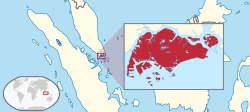 Singapore (Listeni/ˈsɪŋəpɔr/ or /ˈsɪŋɡəpɔr/), officially the Republic of Singapore, and often referred to as the Lion City, the Garden City, and the Red Dot, is a leading global city-state and island country in Southeast Asia. It lies off the southern tip of the Malay Peninsula, one degree (137 km; 85 mi) north of the equator, and is separated from Peninsular Malaysia by the Straits of Johor to the north and from Indonesia's Riau Islands by the Singapore Strait to the south. Singapore's territory consists of the diamond-shaped main island (commonly referred to as Singapore Island in English and Pulau Ujong in Malay) and more than 60 significantly smaller islets. Since the 1960s, ongoing land reclamation projects have increased Singapore's land area, which is highly urbanised, by at least 20%.
Singapore (Listeni/ˈsɪŋəpɔr/ or /ˈsɪŋɡəpɔr/), officially the Republic of Singapore, and often referred to as the Lion City, the Garden City, and the Red Dot, is a leading global city-state and island country in Southeast Asia. It lies off the southern tip of the Malay Peninsula, one degree (137 km; 85 mi) north of the equator, and is separated from Peninsular Malaysia by the Straits of Johor to the north and from Indonesia's Riau Islands by the Singapore Strait to the south. Singapore's territory consists of the diamond-shaped main island (commonly referred to as Singapore Island in English and Pulau Ujong in Malay) and more than 60 significantly smaller islets. Since the 1960s, ongoing land reclamation projects have increased Singapore's land area, which is highly urbanised, by at least 20%.The islands were settled in the second century AD and subsequently belonged to a series of local empires. Modern Singapore was founded in 1819 by Sir Stamford Raffles as a trading post of the East India Company; after the company collapsed, the British obtained sovereignty of the islands in 1824, and Singapore became one of the British Straits Settlements in 1826. Occupied by the Japanese during World War II, Singapore became independent from the United Kingdom in 1963 by uniting with other former British territories to form Malaysia, but was expelled two years later over ideological differences. After experiencing turbulence in its early years as a nation, and despite insufficient natural resources and no hinterland, Singapore embarked on a path of development, as an Asian tiger economy, based on external trade and its human capital.


